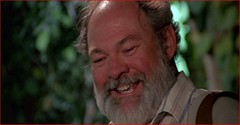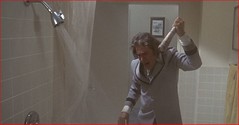While Mario Bava's Bay of Blood has widely been charged with being the inspiration behind Friday the 13th and other 80s "body count" movies, the director's next movie may have provided the inspiration for John Carpenter's classic Halloween. Like Michael Myers, Baron Blood's title villain is seldom seen, and practically swims through the director's horrific shadows and fog. There's also the matter of multiple creative and gory death scenes, continuing a popular theme from Bay of Blood that would be permanently adopted by the horror genre in the following decade. Baron Blood may have laid the groundwork for future slasher pictures, but its own foundation was hardly original, with a story similar to countless Haunted Castle horrors from the 1940s and 50s. On paper Baron Blood would appear to be no different than most entries in its genre, but Bava is able to raise the movie above the material by exploiting the striking castle location and filling it with his trademark visuals. What also helps the movie is Bava's willingness to add a bit of camp to the atmosphere (like he did famously with Danger: Diabolik): a major twist to the title character isn't taken as seriously as perhaps it is written in the script, and the result is a final act that initially feels like Scooby Doo before a surprisingly satisfying and gory conclusion.
The film opens with American graduate student Peter returning to his ancenstral castle in Austria. The lad is familiar with his infamous relative Baron Otto von Kleist, who allegedly terrorized the area centuries ago before meeting his doom at the hands of a witch. With a handy parchment in tow, Peter hopes reciting a ghastly incantation will resurrect the dead sadist, and laughs will likely ensue ... what could possibly go wrong? In Austria, Peter finds the castle being renovated as a tourist attraction by the lovely architect Eva (Elke Sommer), who has taken the liberty of preserving the castle's torture chamber. But after wooing Eva and successfully reciting the incantations, the vacation starts to go wrong for Peter: the parchment accidentally falls into a fire, and the Baron is now on the loose. Finding his castle a tourist trap (complete with a Coca-Cola machine!), the Baron sets out on an eviction spree -- and he may just put that torture chamber back in working order.

When the Baron rises from the grave, Baron Blood grabs your attention and doesn't let go until the final shot. The undead, cloaked Baron exists mostly as a silhouette in between Bava's world of shadows, and we occasionally get a glimpse of his decaying face. With the Baron on the loose we start to see the castle as a decaying house of death instead of a tourist trap, with endless staircases and dark corners. In one memorable scene, Peter and Eva find themselves in the balcony of the castle's sanctuary and Bava's camera moves from Eva's shoulder to a near nose-dive into the pews below. On the big screen the shot might induce motion sickness, and is a great example of how Bava's filmmaking style catching you off guard. Even in the requisite cat-and-mouse sequence between Eva and the Baron, Bava is able to create an exhilirating chase inside and out of the castle, with his lighting acting as the real star between the two performers.

While the Baron is wreaking havoc, Peter and Eva start hatching a plan to get rid of the ghoul -- hmm, that parchment would have come in handy right about now. Without the incantation that would have sent him back to the grave, the pair turn to a local psychic who will attempt to channel Elizabeth Holly, the witch who originally vanquished the Baron. This scene is border-line spectacular: the group builds a fire at the spot where Holly was executed long ago, and soon we see her spirit in the fire, using the psychic to tell Eva and Peter about a weakness of the Baron. Even with the film's limited budget, the special effects in this scene are almost perfect. But before we can get rid of the Baron, who's this old guy (Joseph Cotten) who just purchased the castle at an auction? He seems to know a lot about the Baron, and he does a lot of cackling. Could he actually be Baron Blood? Cotten does everything but wink at the camera about this possibility. This aspect of the story was probably written to be a twist at the end, but Bava makes no illusions about the mysterious man's true identity. The old man is happy to give a tour of his newly-purchased castle, especially the stylish torture chamber where our final act will play out. The ending is flat-out fantastic, a startling resolution where the Baron gets a dose (or 10) of his own medicine in his own torture chamber.
The film opens with American graduate student Peter returning to his ancenstral castle in Austria. The lad is familiar with his infamous relative Baron Otto von Kleist, who allegedly terrorized the area centuries ago before meeting his doom at the hands of a witch. With a handy parchment in tow, Peter hopes reciting a ghastly incantation will resurrect the dead sadist, and laughs will likely ensue ... what could possibly go wrong? In Austria, Peter finds the castle being renovated as a tourist attraction by the lovely architect Eva (Elke Sommer), who has taken the liberty of preserving the castle's torture chamber. But after wooing Eva and successfully reciting the incantations, the vacation starts to go wrong for Peter: the parchment accidentally falls into a fire, and the Baron is now on the loose. Finding his castle a tourist trap (complete with a Coca-Cola machine!), the Baron sets out on an eviction spree -- and he may just put that torture chamber back in working order.

When the Baron rises from the grave, Baron Blood grabs your attention and doesn't let go until the final shot. The undead, cloaked Baron exists mostly as a silhouette in between Bava's world of shadows, and we occasionally get a glimpse of his decaying face. With the Baron on the loose we start to see the castle as a decaying house of death instead of a tourist trap, with endless staircases and dark corners. In one memorable scene, Peter and Eva find themselves in the balcony of the castle's sanctuary and Bava's camera moves from Eva's shoulder to a near nose-dive into the pews below. On the big screen the shot might induce motion sickness, and is a great example of how Bava's filmmaking style catching you off guard. Even in the requisite cat-and-mouse sequence between Eva and the Baron, Bava is able to create an exhilirating chase inside and out of the castle, with his lighting acting as the real star between the two performers.

While the Baron is wreaking havoc, Peter and Eva start hatching a plan to get rid of the ghoul -- hmm, that parchment would have come in handy right about now. Without the incantation that would have sent him back to the grave, the pair turn to a local psychic who will attempt to channel Elizabeth Holly, the witch who originally vanquished the Baron. This scene is border-line spectacular: the group builds a fire at the spot where Holly was executed long ago, and soon we see her spirit in the fire, using the psychic to tell Eva and Peter about a weakness of the Baron. Even with the film's limited budget, the special effects in this scene are almost perfect. But before we can get rid of the Baron, who's this old guy (Joseph Cotten) who just purchased the castle at an auction? He seems to know a lot about the Baron, and he does a lot of cackling. Could he actually be Baron Blood? Cotten does everything but wink at the camera about this possibility. This aspect of the story was probably written to be a twist at the end, but Bava makes no illusions about the mysterious man's true identity. The old man is happy to give a tour of his newly-purchased castle, especially the stylish torture chamber where our final act will play out. The ending is flat-out fantastic, a startling resolution where the Baron gets a dose (or 10) of his own medicine in his own torture chamber.

Tim Lucas notes in the commentary that Baron Blood was a personal triumph for Bava in the fact that he got to film in a real castle -- after years of using matte paintings and other tricks for such locale. It's easy to see that Bava was not going to let this excellent location go wasted -- one scene plays the structure like it's another living and breathing character, practically "watching" a young girl who is outside its walls. The young girl is one of a handful of great secondary characters, as her youth allows her to see the Baron's spirit before the adults, and even see through his old man disguise. Produced by Alfredo Leone, Baron Blood was an international hit and resulted in another Leone-Bava production, Lisa and the Devil (in which Bava was given total creative control and a large budget). Baron Blood may never be put amongst the more popular of Bava's movies, but it has no shortage of the director's signature "moments" -- particularly the sinister ending and the aforementioned witch channeling scene. As with all the other films in The Bava Box 2, Baron Blood looks and sounds excellent, and Lucas has plenty to say in his usual scholarly commentary.













No comments:
Post a Comment